Kaplan Business School: MBA501 Stakeholder Analysis of Facebook
VerifiedAdded on 2022/10/08
|10
|1758
|10
Report
AI Summary
This report presents a comprehensive stakeholder analysis of Facebook, Inc., examining its internal and external stakeholders. The analysis begins with an introduction to Facebook, outlining its vision, mission, recent developments, challenges, and industry trends. A stakeholder view model is provided, categorizing stakeholders into internal (employees, owners, managers) and external (government, suppliers, creditors, customers, advertisers, shareholders) groups. The report then focuses on four key stakeholder groups: government, customers, advertisers, and employees. For each group, the report analyzes their behavior, motives, and potential for collaboration with Facebook, including specific strategies employed by the company. The analysis highlights the importance of these stakeholders in ensuring Facebook's profitability, customer satisfaction, and overall success, emphasizing the need for effective stakeholder management strategies. The report concludes by summarizing the key findings and their implications for Facebook's strategic approach. The report also includes references to the sources used.
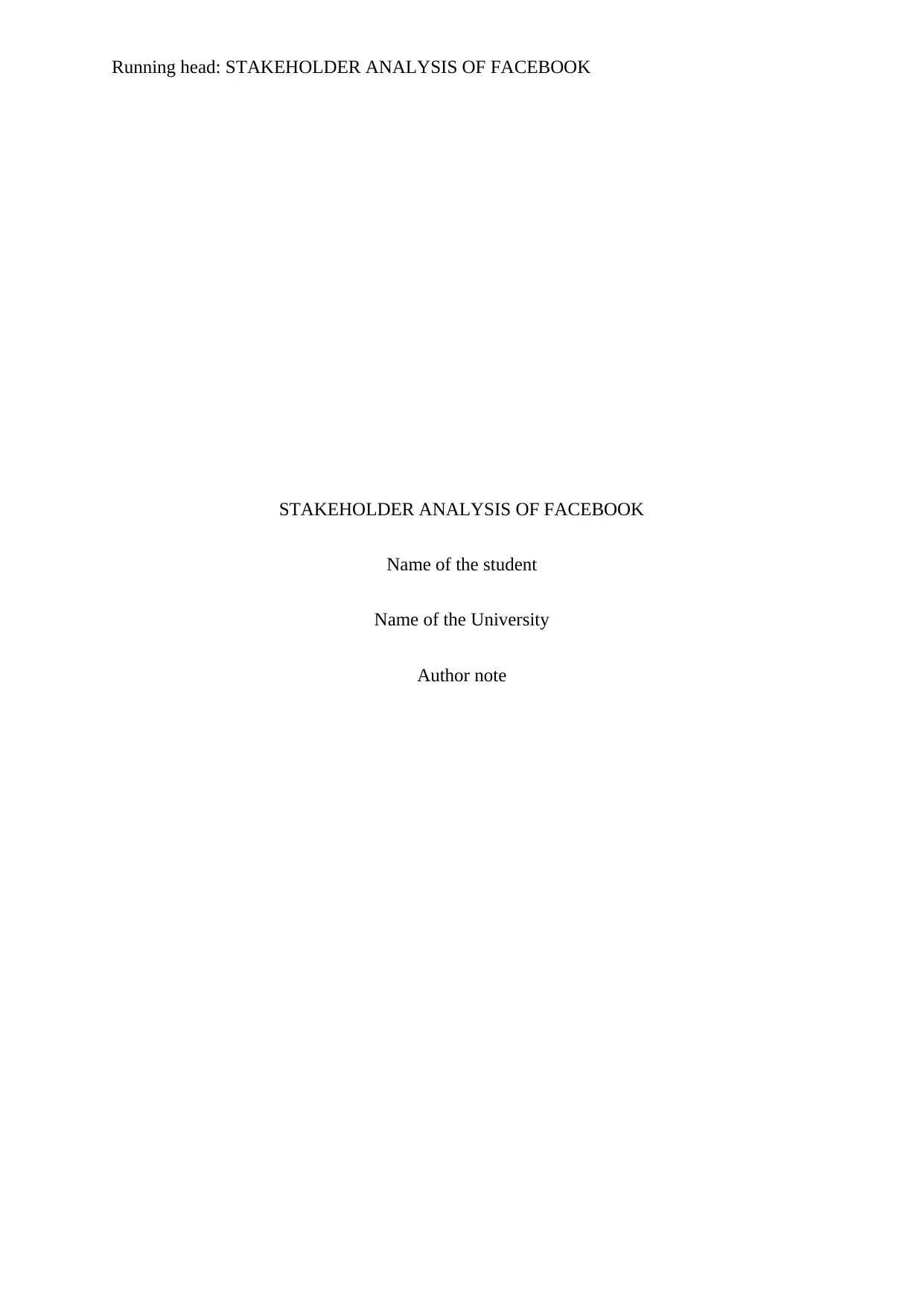
Running head: STAKEHOLDER ANALYSIS OF FACEBOOK
STAKEHOLDER ANALYSIS OF FACEBOOK
Name of the student
Name of the University
Author note
STAKEHOLDER ANALYSIS OF FACEBOOK
Name of the student
Name of the University
Author note
Paraphrase This Document
Need a fresh take? Get an instant paraphrase of this document with our AI Paraphraser
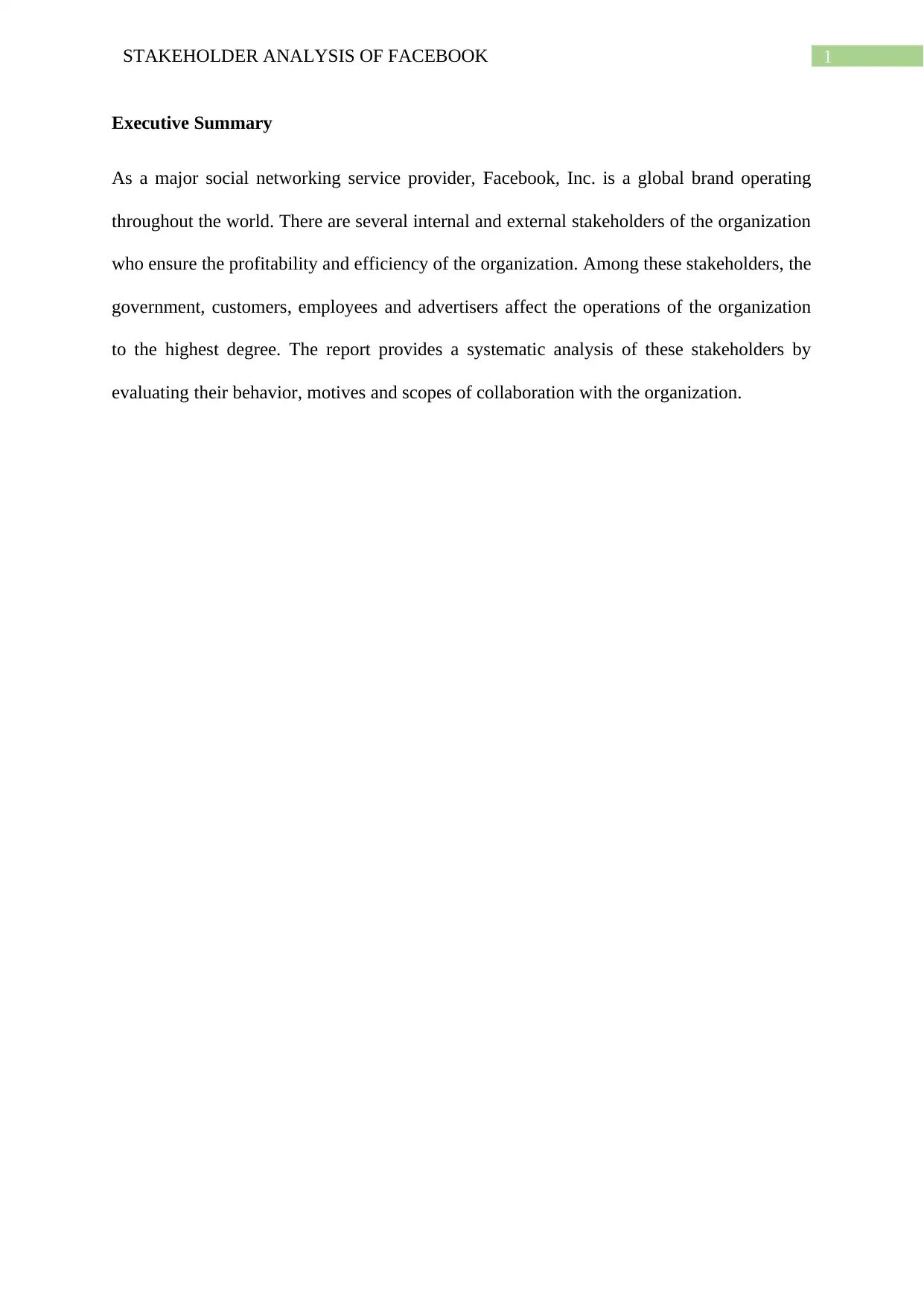
1STAKEHOLDER ANALYSIS OF FACEBOOK
Executive Summary
As a major social networking service provider, Facebook, Inc. is a global brand operating
throughout the world. There are several internal and external stakeholders of the organization
who ensure the profitability and efficiency of the organization. Among these stakeholders, the
government, customers, employees and advertisers affect the operations of the organization
to the highest degree. The report provides a systematic analysis of these stakeholders by
evaluating their behavior, motives and scopes of collaboration with the organization.
Executive Summary
As a major social networking service provider, Facebook, Inc. is a global brand operating
throughout the world. There are several internal and external stakeholders of the organization
who ensure the profitability and efficiency of the organization. Among these stakeholders, the
government, customers, employees and advertisers affect the operations of the organization
to the highest degree. The report provides a systematic analysis of these stakeholders by
evaluating their behavior, motives and scopes of collaboration with the organization.
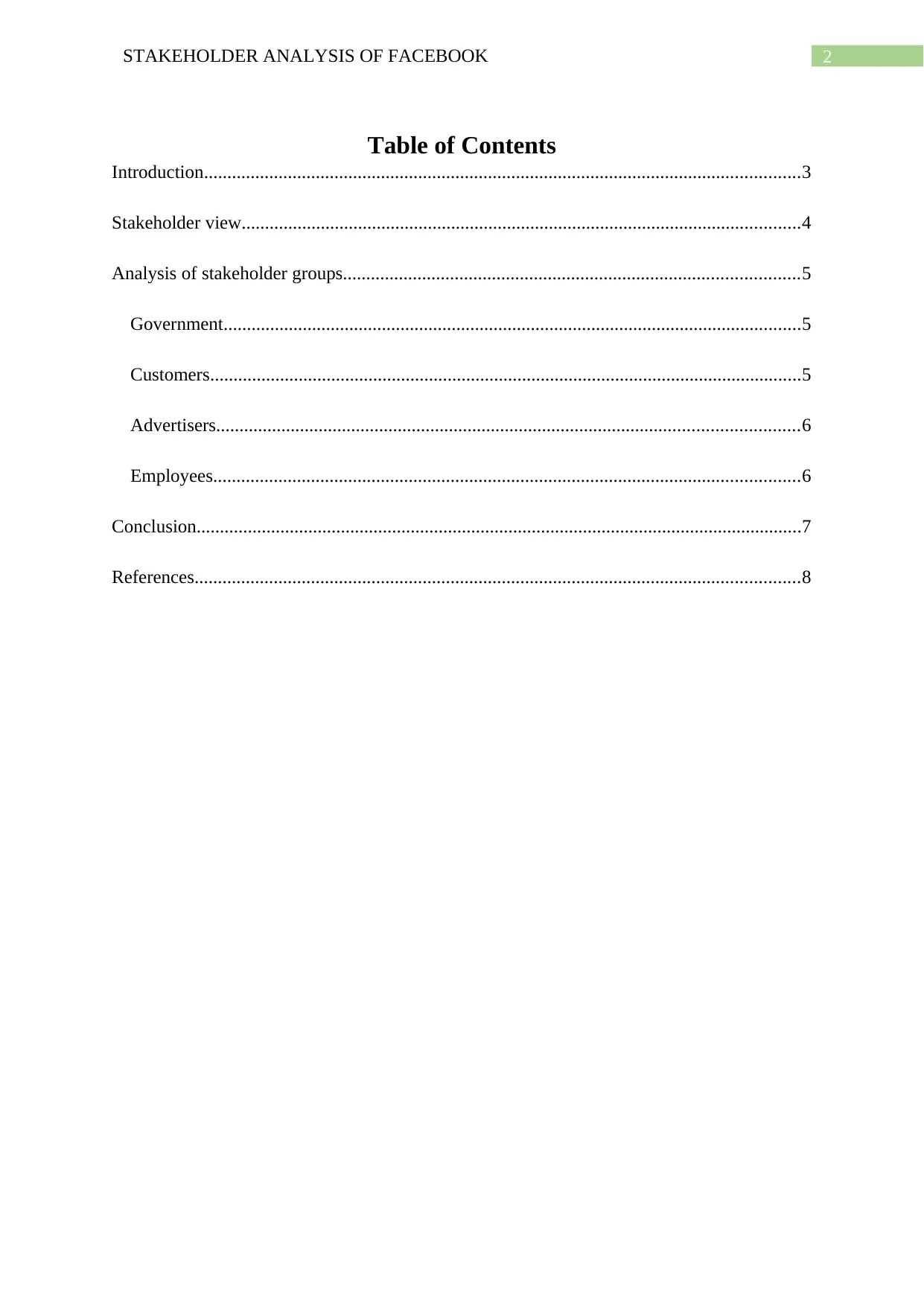
2STAKEHOLDER ANALYSIS OF FACEBOOK
Table of Contents
Introduction................................................................................................................................3
Stakeholder view........................................................................................................................4
Analysis of stakeholder groups..................................................................................................5
Government............................................................................................................................5
Customers...............................................................................................................................5
Advertisers.............................................................................................................................6
Employees..............................................................................................................................6
Conclusion..................................................................................................................................7
References..................................................................................................................................8
Table of Contents
Introduction................................................................................................................................3
Stakeholder view........................................................................................................................4
Analysis of stakeholder groups..................................................................................................5
Government............................................................................................................................5
Customers...............................................................................................................................5
Advertisers.............................................................................................................................6
Employees..............................................................................................................................6
Conclusion..................................................................................................................................7
References..................................................................................................................................8
⊘ This is a preview!⊘
Do you want full access?
Subscribe today to unlock all pages.

Trusted by 1+ million students worldwide
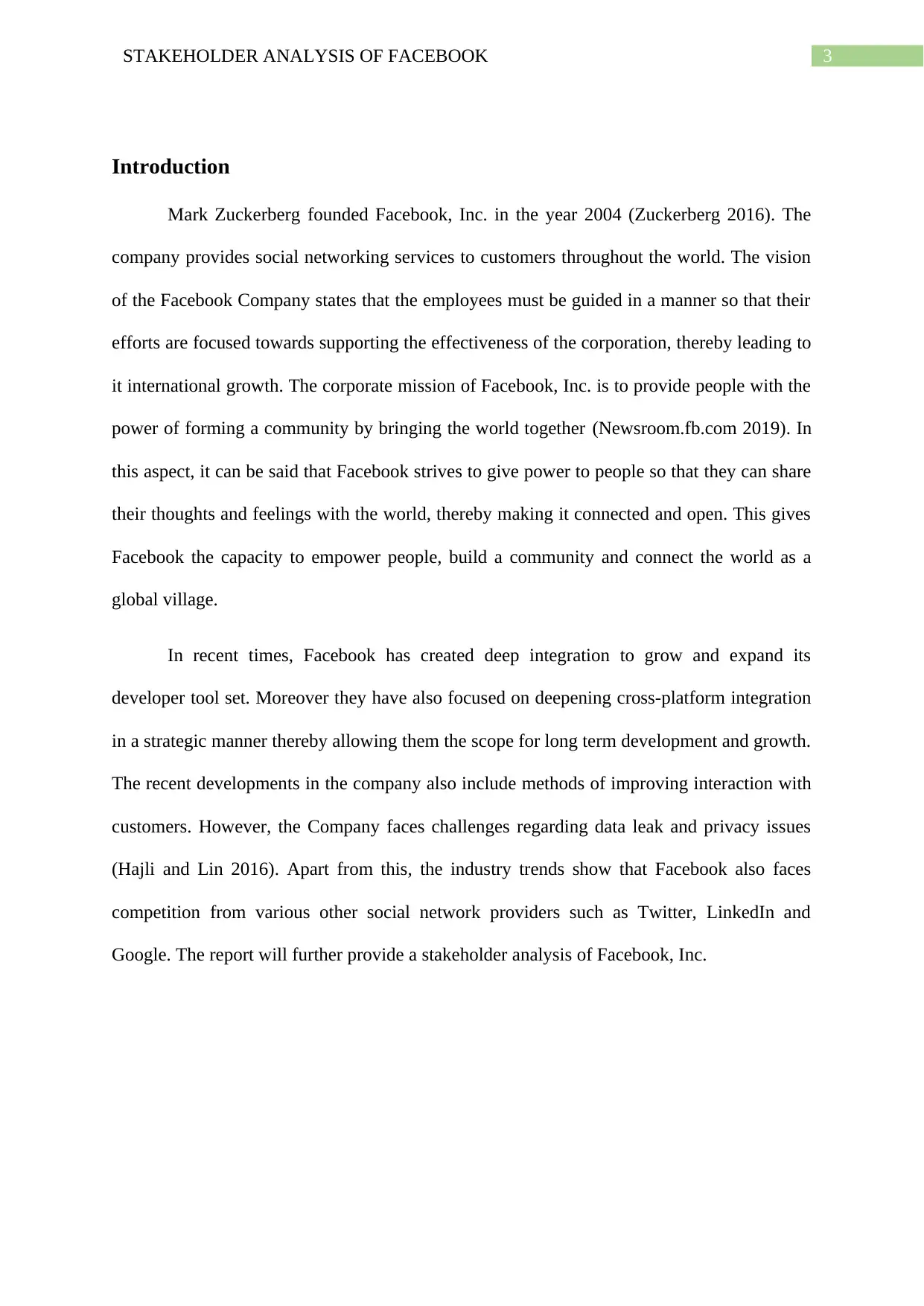
3STAKEHOLDER ANALYSIS OF FACEBOOK
Introduction
Mark Zuckerberg founded Facebook, Inc. in the year 2004 (Zuckerberg 2016). The
company provides social networking services to customers throughout the world. The vision
of the Facebook Company states that the employees must be guided in a manner so that their
efforts are focused towards supporting the effectiveness of the corporation, thereby leading to
it international growth. The corporate mission of Facebook, Inc. is to provide people with the
power of forming a community by bringing the world together (Newsroom.fb.com 2019). In
this aspect, it can be said that Facebook strives to give power to people so that they can share
their thoughts and feelings with the world, thereby making it connected and open. This gives
Facebook the capacity to empower people, build a community and connect the world as a
global village.
In recent times, Facebook has created deep integration to grow and expand its
developer tool set. Moreover they have also focused on deepening cross-platform integration
in a strategic manner thereby allowing them the scope for long term development and growth.
The recent developments in the company also include methods of improving interaction with
customers. However, the Company faces challenges regarding data leak and privacy issues
(Hajli and Lin 2016). Apart from this, the industry trends show that Facebook also faces
competition from various other social network providers such as Twitter, LinkedIn and
Google. The report will further provide a stakeholder analysis of Facebook, Inc.
Introduction
Mark Zuckerberg founded Facebook, Inc. in the year 2004 (Zuckerberg 2016). The
company provides social networking services to customers throughout the world. The vision
of the Facebook Company states that the employees must be guided in a manner so that their
efforts are focused towards supporting the effectiveness of the corporation, thereby leading to
it international growth. The corporate mission of Facebook, Inc. is to provide people with the
power of forming a community by bringing the world together (Newsroom.fb.com 2019). In
this aspect, it can be said that Facebook strives to give power to people so that they can share
their thoughts and feelings with the world, thereby making it connected and open. This gives
Facebook the capacity to empower people, build a community and connect the world as a
global village.
In recent times, Facebook has created deep integration to grow and expand its
developer tool set. Moreover they have also focused on deepening cross-platform integration
in a strategic manner thereby allowing them the scope for long term development and growth.
The recent developments in the company also include methods of improving interaction with
customers. However, the Company faces challenges regarding data leak and privacy issues
(Hajli and Lin 2016). Apart from this, the industry trends show that Facebook also faces
competition from various other social network providers such as Twitter, LinkedIn and
Google. The report will further provide a stakeholder analysis of Facebook, Inc.
Paraphrase This Document
Need a fresh take? Get an instant paraphrase of this document with our AI Paraphraser
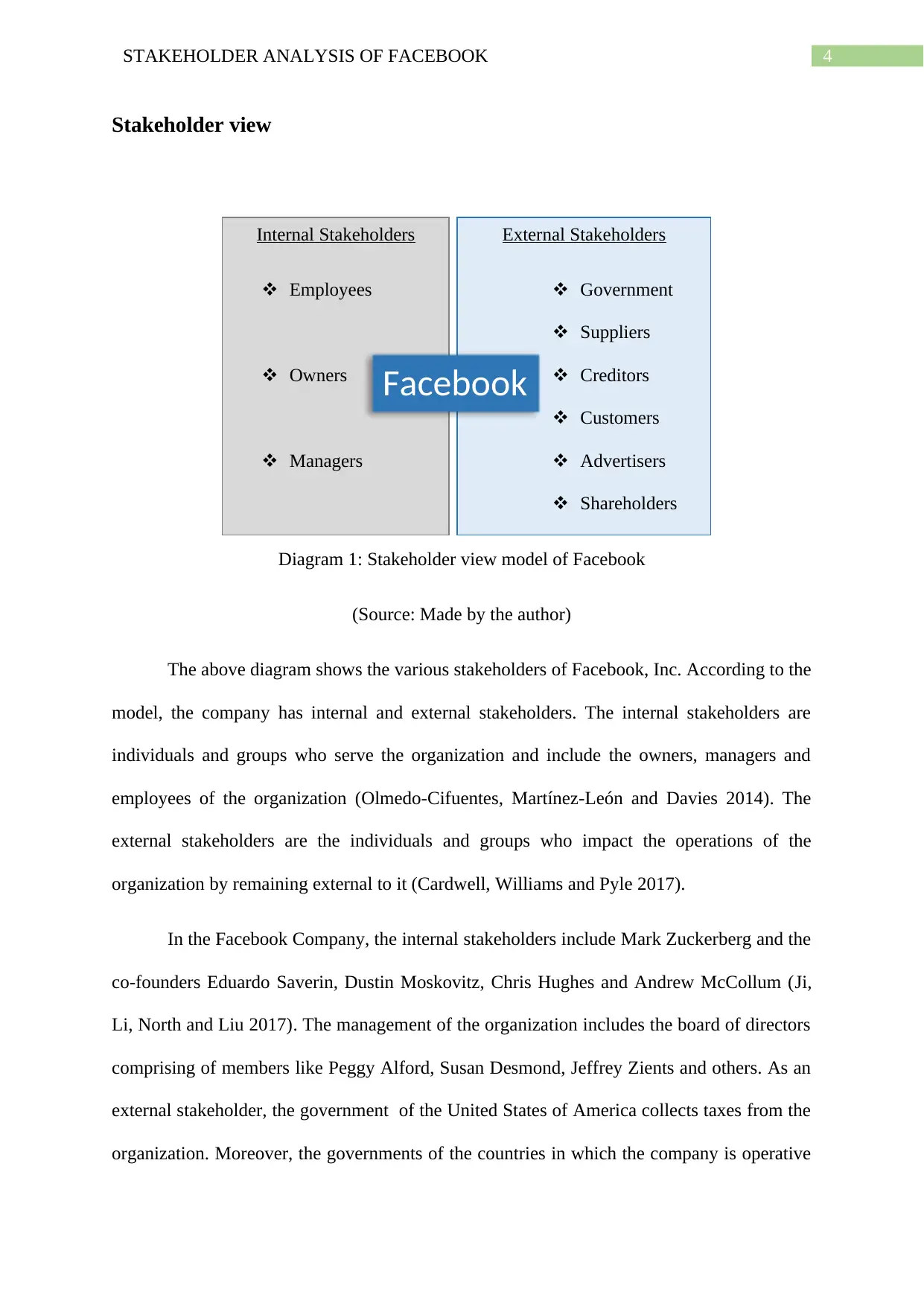
4STAKEHOLDER ANALYSIS OF FACEBOOK
Stakeholder view
Diagram 1: Stakeholder view model of Facebook
(Source: Made by the author)
The above diagram shows the various stakeholders of Facebook, Inc. According to the
model, the company has internal and external stakeholders. The internal stakeholders are
individuals and groups who serve the organization and include the owners, managers and
employees of the organization (Olmedo-Cifuentes, Martínez-León and Davies 2014). The
external stakeholders are the individuals and groups who impact the operations of the
organization by remaining external to it (Cardwell, Williams and Pyle 2017).
In the Facebook Company, the internal stakeholders include Mark Zuckerberg and the
co-founders Eduardo Saverin, Dustin Moskovitz, Chris Hughes and Andrew McCollum (Ji,
Li, North and Liu 2017). The management of the organization includes the board of directors
comprising of members like Peggy Alford, Susan Desmond, Jeffrey Zients and others. As an
external stakeholder, the government of the United States of America collects taxes from the
organization. Moreover, the governments of the countries in which the company is operative
External Stakeholders
Government
Suppliers
Creditors
Customers
Advertisers
Shareholders
Internal Stakeholders
Employees
Owners
Managers
Facebook
Stakeholder view
Diagram 1: Stakeholder view model of Facebook
(Source: Made by the author)
The above diagram shows the various stakeholders of Facebook, Inc. According to the
model, the company has internal and external stakeholders. The internal stakeholders are
individuals and groups who serve the organization and include the owners, managers and
employees of the organization (Olmedo-Cifuentes, Martínez-León and Davies 2014). The
external stakeholders are the individuals and groups who impact the operations of the
organization by remaining external to it (Cardwell, Williams and Pyle 2017).
In the Facebook Company, the internal stakeholders include Mark Zuckerberg and the
co-founders Eduardo Saverin, Dustin Moskovitz, Chris Hughes and Andrew McCollum (Ji,
Li, North and Liu 2017). The management of the organization includes the board of directors
comprising of members like Peggy Alford, Susan Desmond, Jeffrey Zients and others. As an
external stakeholder, the government of the United States of America collects taxes from the
organization. Moreover, the governments of the countries in which the company is operative
External Stakeholders
Government
Suppliers
Creditors
Customers
Advertisers
Shareholders
Internal Stakeholders
Employees
Owners
Managers
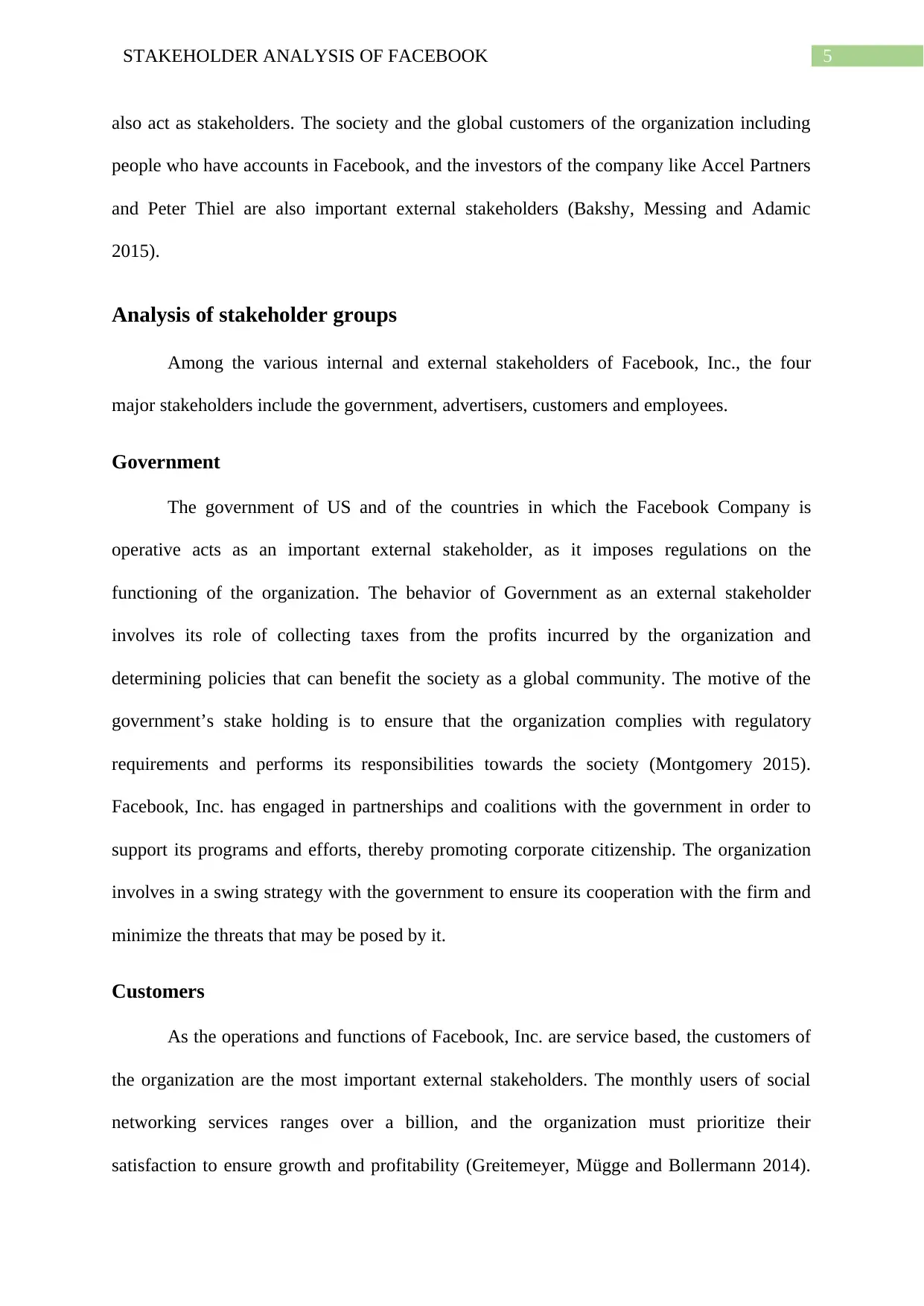
5STAKEHOLDER ANALYSIS OF FACEBOOK
also act as stakeholders. The society and the global customers of the organization including
people who have accounts in Facebook, and the investors of the company like Accel Partners
and Peter Thiel are also important external stakeholders (Bakshy, Messing and Adamic
2015).
Analysis of stakeholder groups
Among the various internal and external stakeholders of Facebook, Inc., the four
major stakeholders include the government, advertisers, customers and employees.
Government
The government of US and of the countries in which the Facebook Company is
operative acts as an important external stakeholder, as it imposes regulations on the
functioning of the organization. The behavior of Government as an external stakeholder
involves its role of collecting taxes from the profits incurred by the organization and
determining policies that can benefit the society as a global community. The motive of the
government’s stake holding is to ensure that the organization complies with regulatory
requirements and performs its responsibilities towards the society (Montgomery 2015).
Facebook, Inc. has engaged in partnerships and coalitions with the government in order to
support its programs and efforts, thereby promoting corporate citizenship. The organization
involves in a swing strategy with the government to ensure its cooperation with the firm and
minimize the threats that may be posed by it.
Customers
As the operations and functions of Facebook, Inc. are service based, the customers of
the organization are the most important external stakeholders. The monthly users of social
networking services ranges over a billion, and the organization must prioritize their
satisfaction to ensure growth and profitability (Greitemeyer, Mügge and Bollermann 2014).
also act as stakeholders. The society and the global customers of the organization including
people who have accounts in Facebook, and the investors of the company like Accel Partners
and Peter Thiel are also important external stakeholders (Bakshy, Messing and Adamic
2015).
Analysis of stakeholder groups
Among the various internal and external stakeholders of Facebook, Inc., the four
major stakeholders include the government, advertisers, customers and employees.
Government
The government of US and of the countries in which the Facebook Company is
operative acts as an important external stakeholder, as it imposes regulations on the
functioning of the organization. The behavior of Government as an external stakeholder
involves its role of collecting taxes from the profits incurred by the organization and
determining policies that can benefit the society as a global community. The motive of the
government’s stake holding is to ensure that the organization complies with regulatory
requirements and performs its responsibilities towards the society (Montgomery 2015).
Facebook, Inc. has engaged in partnerships and coalitions with the government in order to
support its programs and efforts, thereby promoting corporate citizenship. The organization
involves in a swing strategy with the government to ensure its cooperation with the firm and
minimize the threats that may be posed by it.
Customers
As the operations and functions of Facebook, Inc. are service based, the customers of
the organization are the most important external stakeholders. The monthly users of social
networking services ranges over a billion, and the organization must prioritize their
satisfaction to ensure growth and profitability (Greitemeyer, Mügge and Bollermann 2014).
⊘ This is a preview!⊘
Do you want full access?
Subscribe today to unlock all pages.

Trusted by 1+ million students worldwide
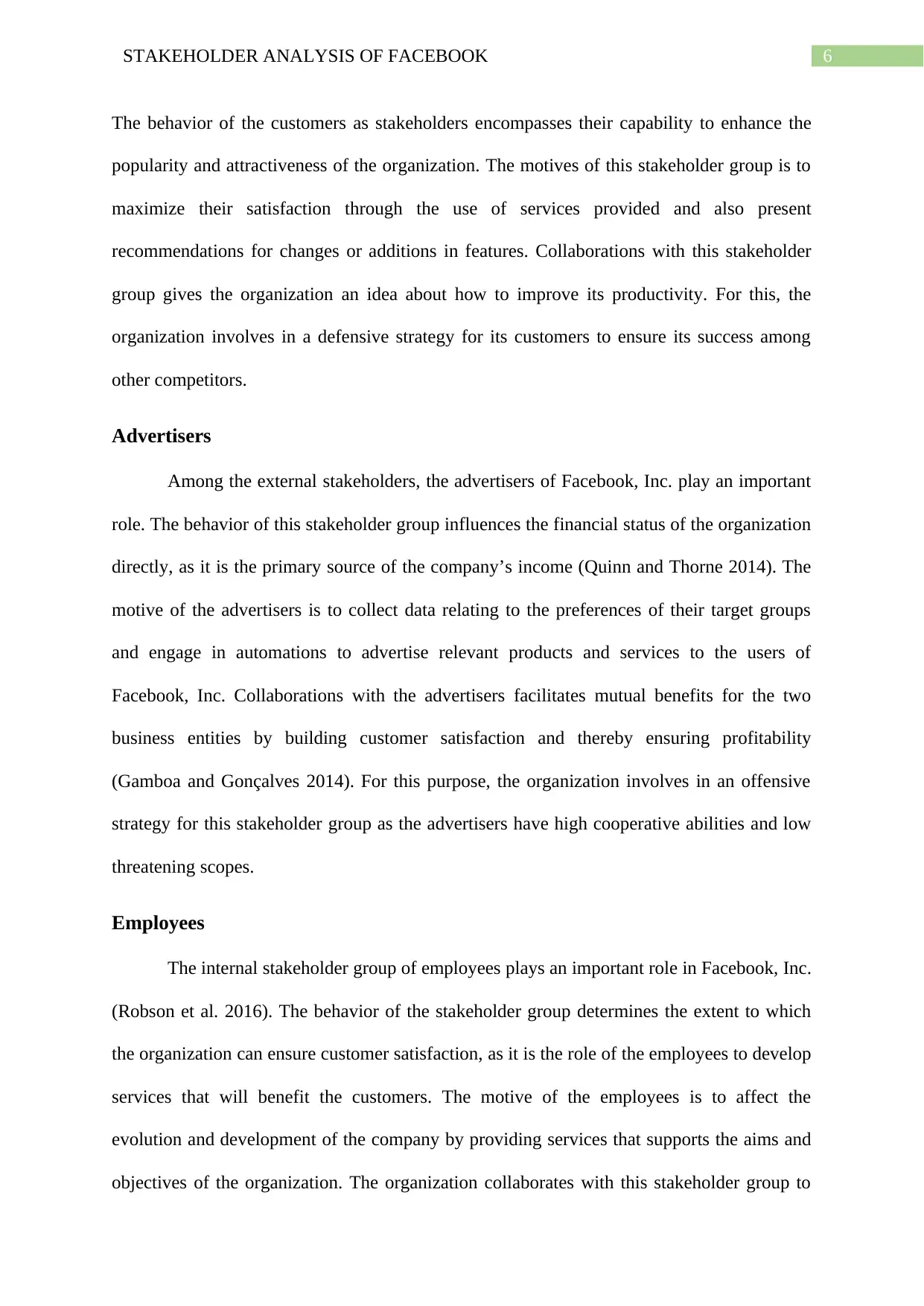
6STAKEHOLDER ANALYSIS OF FACEBOOK
The behavior of the customers as stakeholders encompasses their capability to enhance the
popularity and attractiveness of the organization. The motives of this stakeholder group is to
maximize their satisfaction through the use of services provided and also present
recommendations for changes or additions in features. Collaborations with this stakeholder
group gives the organization an idea about how to improve its productivity. For this, the
organization involves in a defensive strategy for its customers to ensure its success among
other competitors.
Advertisers
Among the external stakeholders, the advertisers of Facebook, Inc. play an important
role. The behavior of this stakeholder group influences the financial status of the organization
directly, as it is the primary source of the company’s income (Quinn and Thorne 2014). The
motive of the advertisers is to collect data relating to the preferences of their target groups
and engage in automations to advertise relevant products and services to the users of
Facebook, Inc. Collaborations with the advertisers facilitates mutual benefits for the two
business entities by building customer satisfaction and thereby ensuring profitability
(Gamboa and Gonçalves 2014). For this purpose, the organization involves in an offensive
strategy for this stakeholder group as the advertisers have high cooperative abilities and low
threatening scopes.
Employees
The internal stakeholder group of employees plays an important role in Facebook, Inc.
(Robson et al. 2016). The behavior of the stakeholder group determines the extent to which
the organization can ensure customer satisfaction, as it is the role of the employees to develop
services that will benefit the customers. The motive of the employees is to affect the
evolution and development of the company by providing services that supports the aims and
objectives of the organization. The organization collaborates with this stakeholder group to
The behavior of the customers as stakeholders encompasses their capability to enhance the
popularity and attractiveness of the organization. The motives of this stakeholder group is to
maximize their satisfaction through the use of services provided and also present
recommendations for changes or additions in features. Collaborations with this stakeholder
group gives the organization an idea about how to improve its productivity. For this, the
organization involves in a defensive strategy for its customers to ensure its success among
other competitors.
Advertisers
Among the external stakeholders, the advertisers of Facebook, Inc. play an important
role. The behavior of this stakeholder group influences the financial status of the organization
directly, as it is the primary source of the company’s income (Quinn and Thorne 2014). The
motive of the advertisers is to collect data relating to the preferences of their target groups
and engage in automations to advertise relevant products and services to the users of
Facebook, Inc. Collaborations with the advertisers facilitates mutual benefits for the two
business entities by building customer satisfaction and thereby ensuring profitability
(Gamboa and Gonçalves 2014). For this purpose, the organization involves in an offensive
strategy for this stakeholder group as the advertisers have high cooperative abilities and low
threatening scopes.
Employees
The internal stakeholder group of employees plays an important role in Facebook, Inc.
(Robson et al. 2016). The behavior of the stakeholder group determines the extent to which
the organization can ensure customer satisfaction, as it is the role of the employees to develop
services that will benefit the customers. The motive of the employees is to affect the
evolution and development of the company by providing services that supports the aims and
objectives of the organization. The organization collaborates with this stakeholder group to
Paraphrase This Document
Need a fresh take? Get an instant paraphrase of this document with our AI Paraphraser
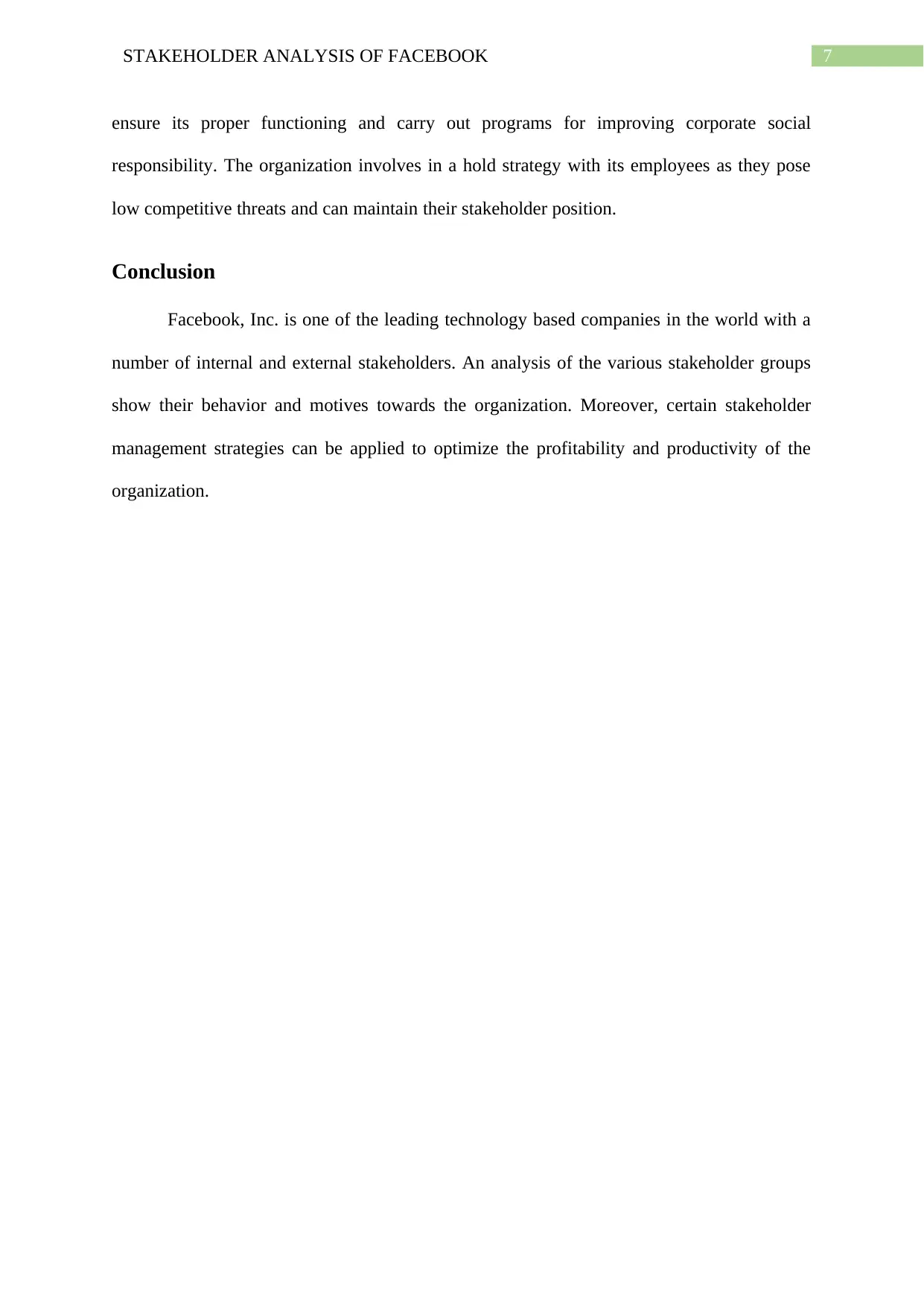
7STAKEHOLDER ANALYSIS OF FACEBOOK
ensure its proper functioning and carry out programs for improving corporate social
responsibility. The organization involves in a hold strategy with its employees as they pose
low competitive threats and can maintain their stakeholder position.
Conclusion
Facebook, Inc. is one of the leading technology based companies in the world with a
number of internal and external stakeholders. An analysis of the various stakeholder groups
show their behavior and motives towards the organization. Moreover, certain stakeholder
management strategies can be applied to optimize the profitability and productivity of the
organization.
ensure its proper functioning and carry out programs for improving corporate social
responsibility. The organization involves in a hold strategy with its employees as they pose
low competitive threats and can maintain their stakeholder position.
Conclusion
Facebook, Inc. is one of the leading technology based companies in the world with a
number of internal and external stakeholders. An analysis of the various stakeholder groups
show their behavior and motives towards the organization. Moreover, certain stakeholder
management strategies can be applied to optimize the profitability and productivity of the
organization.
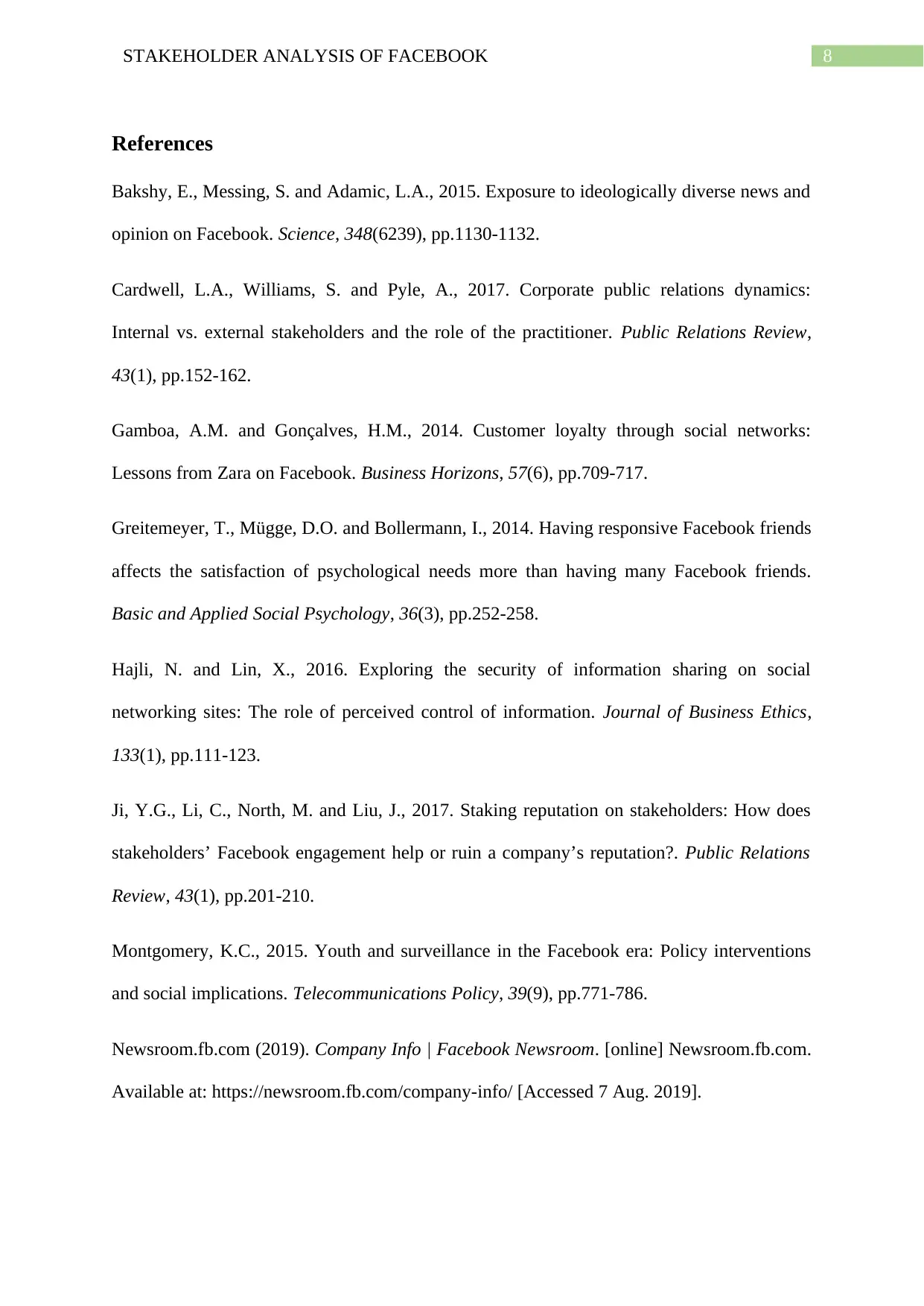
8STAKEHOLDER ANALYSIS OF FACEBOOK
References
Bakshy, E., Messing, S. and Adamic, L.A., 2015. Exposure to ideologically diverse news and
opinion on Facebook. Science, 348(6239), pp.1130-1132.
Cardwell, L.A., Williams, S. and Pyle, A., 2017. Corporate public relations dynamics:
Internal vs. external stakeholders and the role of the practitioner. Public Relations Review,
43(1), pp.152-162.
Gamboa, A.M. and Gonçalves, H.M., 2014. Customer loyalty through social networks:
Lessons from Zara on Facebook. Business Horizons, 57(6), pp.709-717.
Greitemeyer, T., Mügge, D.O. and Bollermann, I., 2014. Having responsive Facebook friends
affects the satisfaction of psychological needs more than having many Facebook friends.
Basic and Applied Social Psychology, 36(3), pp.252-258.
Hajli, N. and Lin, X., 2016. Exploring the security of information sharing on social
networking sites: The role of perceived control of information. Journal of Business Ethics,
133(1), pp.111-123.
Ji, Y.G., Li, C., North, M. and Liu, J., 2017. Staking reputation on stakeholders: How does
stakeholders’ Facebook engagement help or ruin a company’s reputation?. Public Relations
Review, 43(1), pp.201-210.
Montgomery, K.C., 2015. Youth and surveillance in the Facebook era: Policy interventions
and social implications. Telecommunications Policy, 39(9), pp.771-786.
Newsroom.fb.com (2019). Company Info | Facebook Newsroom. [online] Newsroom.fb.com.
Available at: https://newsroom.fb.com/company-info/ [Accessed 7 Aug. 2019].
References
Bakshy, E., Messing, S. and Adamic, L.A., 2015. Exposure to ideologically diverse news and
opinion on Facebook. Science, 348(6239), pp.1130-1132.
Cardwell, L.A., Williams, S. and Pyle, A., 2017. Corporate public relations dynamics:
Internal vs. external stakeholders and the role of the practitioner. Public Relations Review,
43(1), pp.152-162.
Gamboa, A.M. and Gonçalves, H.M., 2014. Customer loyalty through social networks:
Lessons from Zara on Facebook. Business Horizons, 57(6), pp.709-717.
Greitemeyer, T., Mügge, D.O. and Bollermann, I., 2014. Having responsive Facebook friends
affects the satisfaction of psychological needs more than having many Facebook friends.
Basic and Applied Social Psychology, 36(3), pp.252-258.
Hajli, N. and Lin, X., 2016. Exploring the security of information sharing on social
networking sites: The role of perceived control of information. Journal of Business Ethics,
133(1), pp.111-123.
Ji, Y.G., Li, C., North, M. and Liu, J., 2017. Staking reputation on stakeholders: How does
stakeholders’ Facebook engagement help or ruin a company’s reputation?. Public Relations
Review, 43(1), pp.201-210.
Montgomery, K.C., 2015. Youth and surveillance in the Facebook era: Policy interventions
and social implications. Telecommunications Policy, 39(9), pp.771-786.
Newsroom.fb.com (2019). Company Info | Facebook Newsroom. [online] Newsroom.fb.com.
Available at: https://newsroom.fb.com/company-info/ [Accessed 7 Aug. 2019].
⊘ This is a preview!⊘
Do you want full access?
Subscribe today to unlock all pages.

Trusted by 1+ million students worldwide
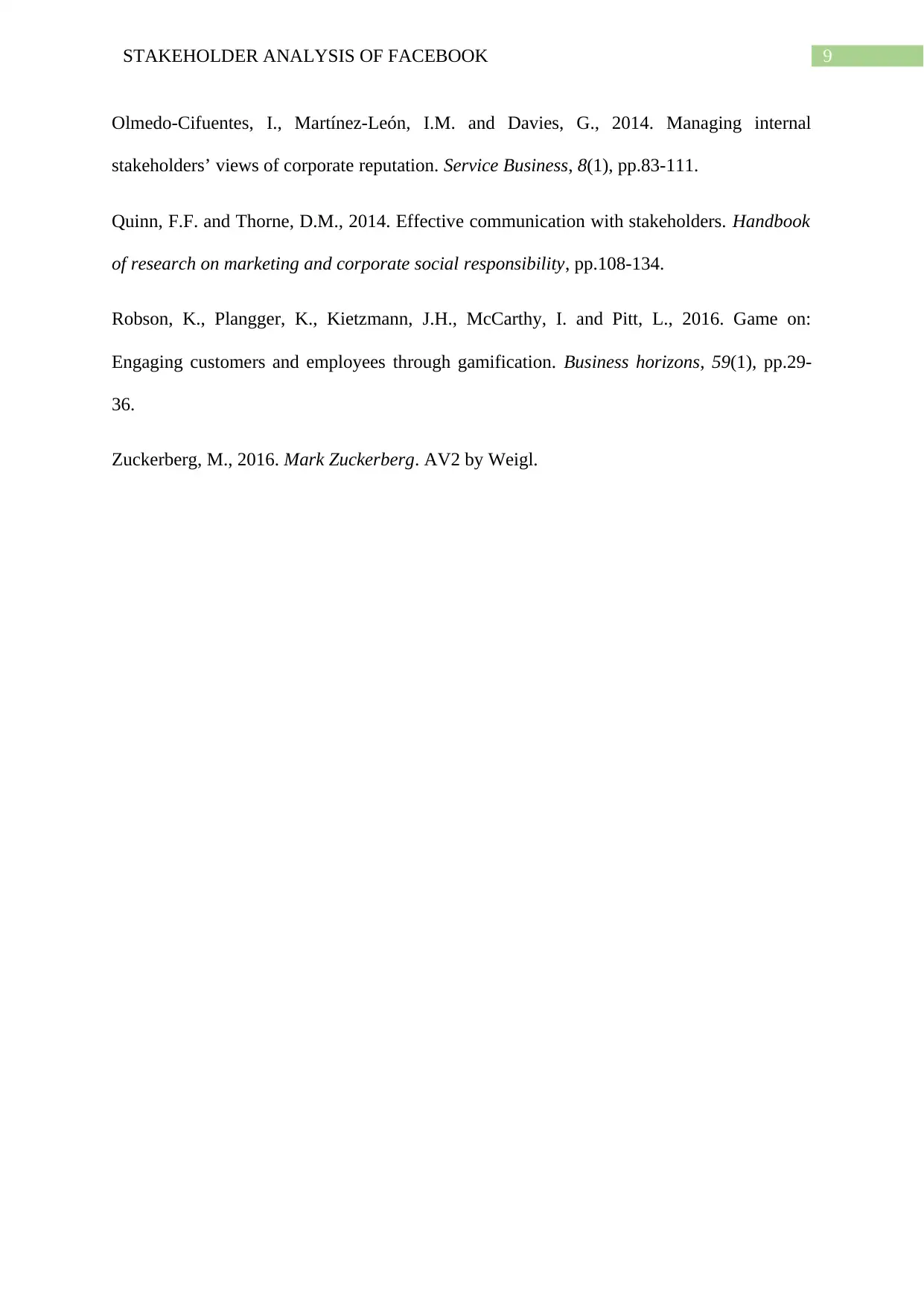
9STAKEHOLDER ANALYSIS OF FACEBOOK
Olmedo-Cifuentes, I., Martínez-León, I.M. and Davies, G., 2014. Managing internal
stakeholders’ views of corporate reputation. Service Business, 8(1), pp.83-111.
Quinn, F.F. and Thorne, D.M., 2014. Effective communication with stakeholders. Handbook
of research on marketing and corporate social responsibility, pp.108-134.
Robson, K., Plangger, K., Kietzmann, J.H., McCarthy, I. and Pitt, L., 2016. Game on:
Engaging customers and employees through gamification. Business horizons, 59(1), pp.29-
36.
Zuckerberg, M., 2016. Mark Zuckerberg. AV2 by Weigl.
Olmedo-Cifuentes, I., Martínez-León, I.M. and Davies, G., 2014. Managing internal
stakeholders’ views of corporate reputation. Service Business, 8(1), pp.83-111.
Quinn, F.F. and Thorne, D.M., 2014. Effective communication with stakeholders. Handbook
of research on marketing and corporate social responsibility, pp.108-134.
Robson, K., Plangger, K., Kietzmann, J.H., McCarthy, I. and Pitt, L., 2016. Game on:
Engaging customers and employees through gamification. Business horizons, 59(1), pp.29-
36.
Zuckerberg, M., 2016. Mark Zuckerberg. AV2 by Weigl.
1 out of 10
Related Documents
Your All-in-One AI-Powered Toolkit for Academic Success.
+13062052269
info@desklib.com
Available 24*7 on WhatsApp / Email
![[object Object]](/_next/static/media/star-bottom.7253800d.svg)
Unlock your academic potential
Copyright © 2020–2025 A2Z Services. All Rights Reserved. Developed and managed by ZUCOL.





